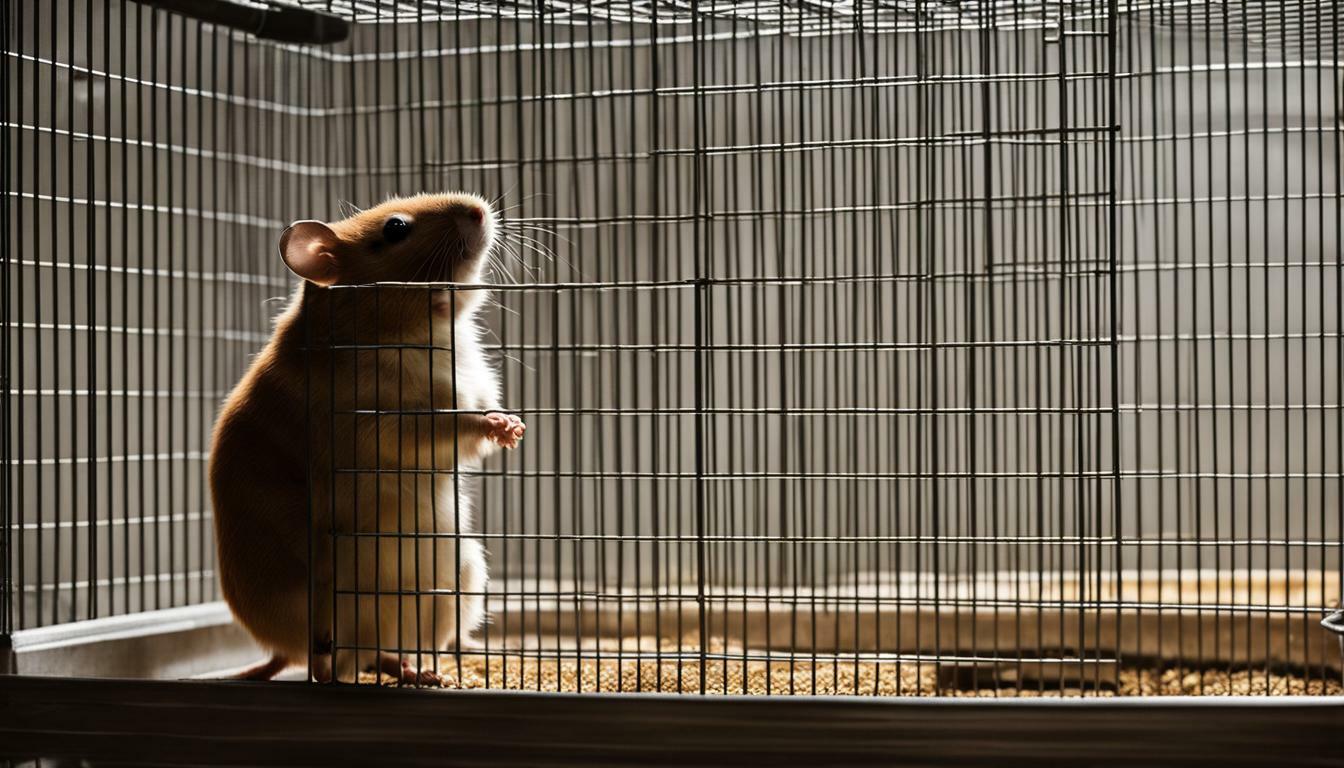Are hamsters social animals that require companionship, or do they prefer to live alone? This is a common question among hamster owners and enthusiasts. Understanding the nature and behavior of hamsters is essential to provide them with the best care possible.
Key Takeaways:
- Hamsters are generally solitary animals and prefer to defend their territory.
- Syrian and Chinese hamsters are highly territorial and should be housed separately to prevent fights.
- Dwarf and Roborovski hamsters can live in small colonies in the wild, but it is not recommended to keep them together domestically due to the risk of aggression.
- Hamsters do not get lonely and do not require the company of another hamster or humans.
- If you decide to keep multiple hamsters, make sure to provide separate cages and introduce them slowly while monitoring their interactions.
Providing a suitable habitat and meeting the individual needs of your hamster is crucial for their well-being. Remember to always prioritize their comfort and safety to ensure a happy and healthy life for your furry friend.
Understanding Hamster Behavior and Territoriality
To understand whether hamsters should be alone, it is important to consider their natural behavior and social tendencies. Hamsters are generally solitary animals and prefer to defend their own territory. This behavior can be traced back to their ancestors in the wild, where they had to fend for themselves and protect their resources from competing individuals.
Syrian and Chinese hamsters, in particular, are highly territorial species. They have a strong instinct to mark their territory and may become aggressive towards other hamsters if they perceive them as a threat. Housing these hamsters together can result in fights and injuries, which can be detrimental to their health and well-being.
Dwarf and Roborovski hamsters, although they can live in small colonies in the wild, still exhibit territorial behavior. It is not recommended to keep them together domestically as fights can still break out, leading to stress and potential harm to both hamsters involved.
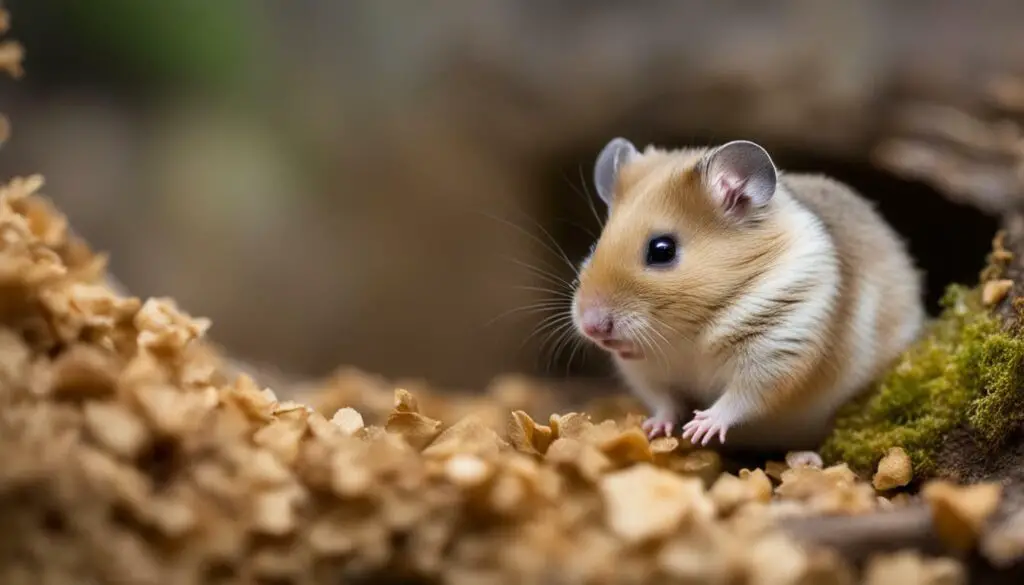
Contrary to popular belief, hamsters do not get lonely and do not require the company of another hamster or humans to thrive. They are generally content being independent and self-sufficient. It is important to provide each hamster with its own separate cage, ensuring they have enough space to establish their territory and feel secure.
“Hamsters do not thrive in social groups, and keeping them together can lead to fighting, stress, and potentially serious injuries.”
Keeping hamsters alone also allows you to form a closer bond with them. Interacting with your hamster through playtime and handling can provide them with mental stimulation and enrichment. They are generally friendly with humans and can be happily entertained without the need for another hamster’s companionship.
Best Practices for Hamster Care
When caring for your hamster, it is crucial to prioritize their individual needs. Here are some best practices to consider:
- Provide a suitable habitat with ample space, bedding, and hiding spots to mimic their natural environment.
- Offer a balanced diet of hamster pellets, fresh fruits, vegetables, and occasional treats.
- Ensure clean water is available at all times.
- Provide mental stimulation through toys, tunnels, and exercise wheels.
- Keep the habitat clean and hygienic by regularly removing waste and replacing soiled bedding.
| Hamster Type | Behavior | Housing Recommendation |
|---|---|---|
| Syrian Hamsters | Highly territorial and aggressive towards other hamsters. | Individual housing is recommended. |
| Chinese Hamsters | Highly territorial and prone to fights. | Individual housing is recommended. |
| Dwarf Hamsters | Social in the wild but can still exhibit territorial behavior. | Individual housing is recommended. |
| Roborovski Hamsters | Social in the wild but can still exhibit territorial behavior. | Individual housing is recommended. |
By understanding and respecting the natural behavior of hamsters, we can provide them with the best possible care and ensure their well-being. Remember, hamsters are solitary animals that can thrive individually with proper housing, diet, and enrichment.
Types of Hamsters and Their Housing Needs
Different types of hamsters have varying housing needs, and most of them thrive when provided with their own living space. While some hamsters can tolerate living in small colonies in the wild, it is generally not recommended to house them together domestically. This is due to the potential for fights and conflicts to break out, even among hamsters that are considered more social.
Syrian and Chinese hamsters, for example, are highly territorial species that prefer to live alone. They have a strong instinct to defend their territory and fights can occur if they are housed together. It is important to provide separate cages for these hamsters to ensure their well-being and minimize the risk of aggression.
| Type of Hamster | Housing Needs |
|---|---|
| Syrian Hamsters | Single housing in a spacious cage |
| Chinese Hamsters | Individual enclosures with plenty of hiding spots |
Dwarf and Roborovski hamsters, on the other hand, are known to be more sociable compared to their larger counterparts. However, even though they can live in small colonies in the wild, it is still recommended to provide separate living spaces for them domestically. Fights can still occur among dwarf and Roborovski hamsters, and it is essential to prioritize their safety and well-being.
It is important to note that hamsters do not get lonely and do not require the company of another hamster or humans for their mental well-being. They are generally friendly and enjoy interacting with their human caretakers. Playing and bonding with your hamster is a great way to provide stimulation and enrichment for them.
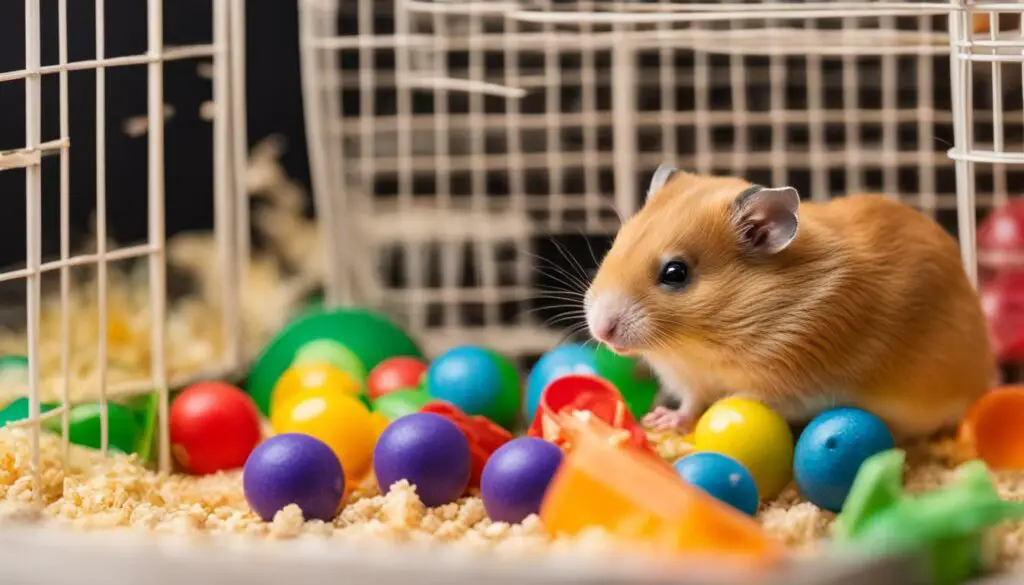
- Provide an appropriate-sized cage with enough room for your hamster to exercise and explore
- Include toys and accessories to keep your hamster mentally stimulated and entertained
- Place the cage in a quiet area away from direct sunlight and drafts
- Make sure the cage is escape-proof and provides adequate ventilation
- Keep the cage clean and provide fresh bedding regularly
- Monitor your hamster’s behavior and health regularly
By understanding the specific housing needs of different types of hamsters and providing them with their own living space, you can ensure a safe and comfortable environment for your furry friend.
Syrian and Chinese Hamsters – Highly Territorial Species
Syrian and Chinese hamsters, known for their territorial behavior, are best kept alone to avoid potential conflicts and promote their well-being. These hamster species have a strong instinct to defend their territory, and housing them together can lead to fights and stress. To ensure the health and happiness of your hamsters, it is essential to provide them with separate living arrangements.
In the wild, Syrian and Chinese hamsters have vast territories that they mark with scent glands. They are solitary animals by nature, preferring to live and explore their environment alone. When housed together, these highly territorial hamsters may become aggressive towards each other, resulting in injuries and even death. It is crucial to respect their natural instincts and provide them with individual cages where they can establish their own territories.
By providing separate living spaces for Syrian and Chinese hamsters, you not only prevent potential conflicts but also promote their overall well-being. Each hamster can have their own hiding spots, beds, food, and water dishes, ensuring they feel safe and secure. This setup allows them to exhibit their natural behaviors without the stress of competition or intrusion from other hamsters. It also simplifies the task of monitoring their health and behavior, as any signs of aggression or illness can be easily detected and addressed.
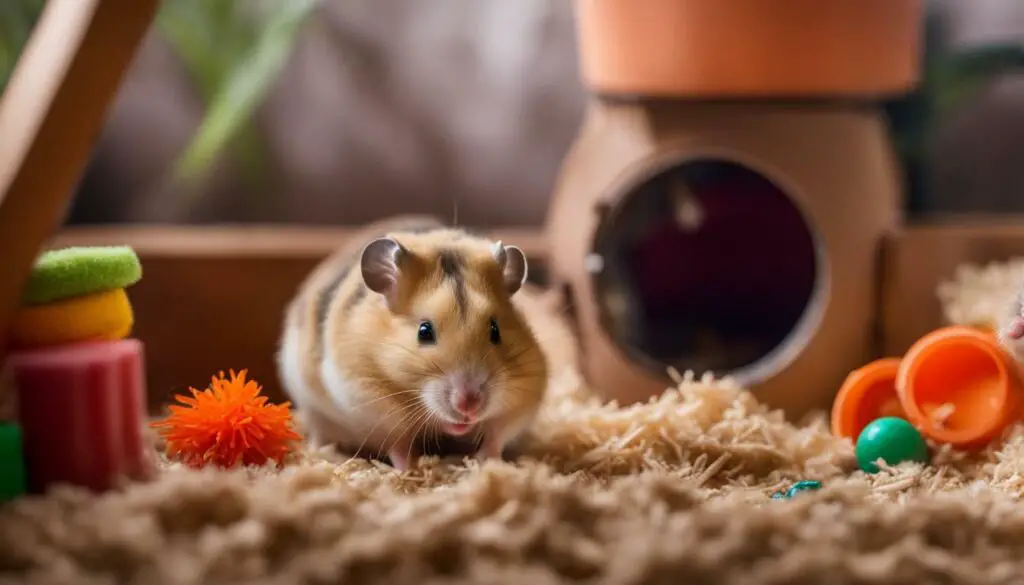
| Benefits of Keeping Syrian and Chinese Hamsters Alone |
|---|
| Prevents fights and injuries caused by territorial disputes. |
| Reduces stress and promotes a safer, more peaceful environment for each hamster. |
| Allows hamsters to establish their own territories and exhibit natural behaviors. |
| Makes it easier to monitor individual health and behavior. |
| Provides each hamster with their own resources, ensuring their needs are met. |
Dwarf and Roborovski Hamsters – Small Colony Dwellers
While dwarf and Roborovski hamsters have a natural tendency to live in small colonies, it is generally advised to keep them separate to prevent aggression and ensure their safety. Although they may thrive in social groups in the wild, domesticated hamsters have different needs and behaviors that must be taken into consideration.
Hamsters are known to be territorial creatures, and even in the case of dwarf and Roborovski hamsters, conflicts can arise if they are housed together. These conflicts can lead to serious injuries or even fatalities. Therefore, it is crucial to provide each hamster with its own cage to maintain their individual territories.
When considering the well-being of your dwarf or Roborovski hamster, it is important to remember that they do not require the companionship of another hamster. They do not experience feelings of loneliness and are content living alone. As long as you provide them with regular interaction, mental stimulation, and a suitable habitat, they can lead happy and fulfilling lives.
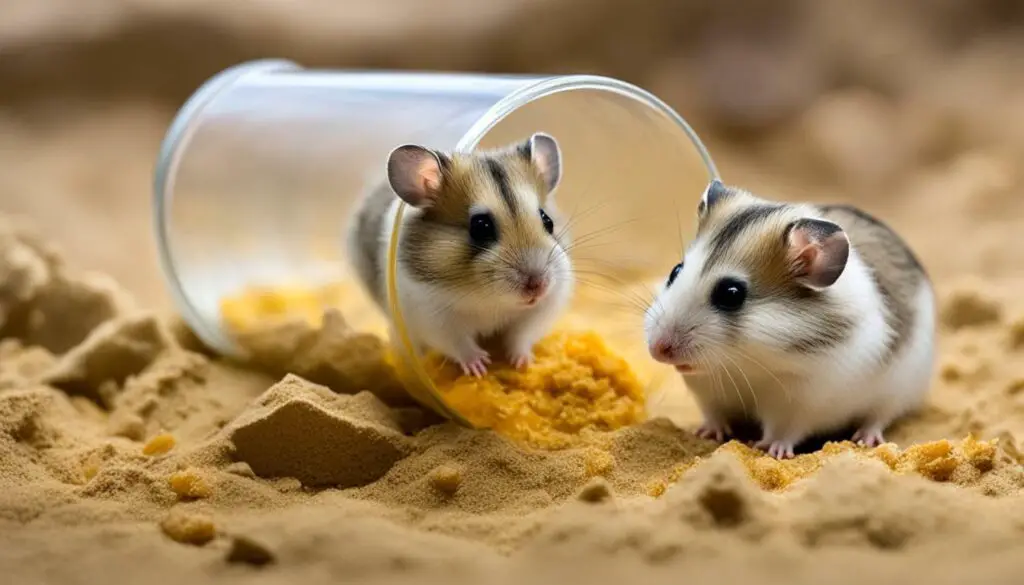
Creating an enriching environment for your hamster is paramount. You can provide them with a variety of toys, tunnels, and hiding places to keep them mentally engaged. Additionally, regular interaction and playtime with your hamster are not only enjoyable but also serve as an opportunity for bonding. Hamsters are generally friendly with humans and can form trusting relationships with their owners.
Socialization and Companionship for Hamsters
Contrary to popular belief, hamsters do not require companionship in the same way humans or other social animals do. Hamsters are solitary animals and prefer to defend their territory. In the wild, they live alone in burrows, coming out at night to scavenge for food and explore their surroundings. This behavior translates to their domesticated counterparts, and it is generally recommended to keep hamsters in separate cages.
However, this doesn’t mean that hamsters cannot interact with their human owners. Hamsters can form a bond with their owners and enjoy spending time outside their cages. They are generally friendly animals that can be easily handled and played with. You can provide enrichment activities and toys to keep them entertained and stimulated.
When it comes to introducing multiple hamsters, it is important to proceed with caution. If you do decide to keep more than one hamster, it is best to introduce them slowly and carefully. Contrary to some hamster species’ natural behavior, fights can occur even among dwarf and Roborovski hamsters if they are housed together.
Monitoring their interactions is crucial to ensure their safety. If you notice any signs of aggression or fighting, it is important to separate them immediately. This can be done by providing separate cages and allowing them to have their own individual space. By closely observing their behavior and providing appropriate living arrangements, you can ensure the well-being of your hamsters.
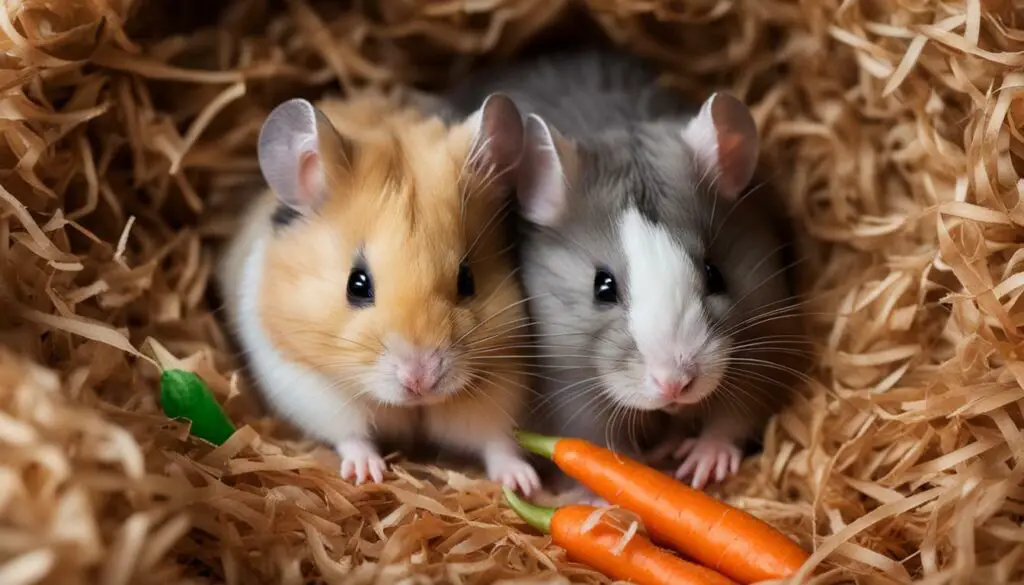
| Pros | Cons |
|---|---|
| Hamsters are independent animals and do not rely on social interactions for their well-being. | There is a risk of aggression and fights if multiple hamsters are housed together. |
| Hamsters form bonds with their owners and enjoy human interaction. | Some hamster species, such as Syrian and Chinese hamsters, are highly territorial and should always be kept alone. |
| Keeping hamsters separate prevents the spread of diseases and reduces stress. | Hamsters may feel stressed or threatened when housed together, leading to health issues or decreased quality of life. |
In summary, hamsters are solitary animals that do not require companionship from other hamsters or humans. While they can form bonds with their owners, it is important to keep them in separate cages to prevent aggression and ensure their well-being. By providing appropriate housing and monitoring their interactions, you can create a safe and enriching environment for your pet hamster.
Introducing Multiple Hamsters
If you decide to keep multiple hamsters, it is crucial to introduce them gradually and monitor their interactions closely. While hamsters are generally solitary animals, some owners may choose to keep more than one for various reasons. However, it is important to understand the potential risks and take necessary precautions to ensure the well-being of your furry friends.
When introducing multiple hamsters, it is best to provide separate cages for each hamster. This allows them to have their own space and reduces the risk of territorial disputes. It is recommended to start by placing the cages near each other, allowing the hamsters to become familiar with each other’s scent without direct contact.
After a few days of scent introduction, you can proceed with a gradual introduction in a neutral space, such as a playpen or a bathtub. Keep a close eye on their behavior during this initial encounter. If any signs of aggression, such as raised fur, biting, or chasing, are observed, immediately separate the hamsters and try again at a later time.
| Signs of Aggression | Recommended Action |
|---|---|
| Raised fur and hissing | Separate the hamsters and give them more time to adjust before attempting another introduction. |
| Biting or chasing | Separate the hamsters immediately to prevent any injuries. Consult a veterinarian if necessary. |
| Excessive dominance or bullying | Consider keeping the hamsters in separate areas permanently to ensure their safety and well-being. |
Remember, not all hamsters may get along even with gradual introductions. Each hamster has its own unique personality, and some simply prefer a solitary life. It is vital to respect their individual preferences and ensure their happiness and safety above all else.
Expert Tip:
“While it can be tempting to introduce multiple hamsters for companionship, it is important to understand that hamsters are generally happier living alone. Providing them with a comfortable and enriched environment, along with regular interaction and playtime with their human caretakers, is more than enough to keep them content.”
Monitoring and Managing Aggression
Aggression is a natural behavior in hamsters, and it is essential to closely monitor their interactions to ensure their well-being. When housing multiple hamsters, it is important to provide them with separate cages to prevent potential conflicts. If you decide to introduce more than one hamster, a slow and careful introduction process is crucial.
When introducing hamsters, start by placing their cages in close proximity to allow them to become familiar with each other’s scent. Monitor their reactions closely during this initial stage. If they appear calm and show no signs of aggression, you can proceed with supervised interactions in a neutral territory. This can be a separate play area where the hamsters can explore and interact under your watchful eye.
If any signs of aggression arise during the introduction process, such as biting, chasing, or excessive vocalizations, it is crucial to separate the hamsters immediately. Aggression can escalate quickly and result in serious injuries. Provide each hamster with their own comfortable and secure space to ensure their safety and well-being.
Table: Signs of Aggression in Hamsters
| Signs of Aggression | Behavioral Indicators |
|---|---|
| Biting | One hamster forcefully biting another |
| Chasing | One hamster pursuing another with intent to attack |
| Vocalizations | Excessive squeaking, hissing, or growling |
| Hair Pulling | One hamster forcefully grabbing and pulling the fur of another |
| Mounting | One hamster mounting and asserting dominance over another |
Remember, each hamster has its own unique personality and tolerance for social interactions. While some hamsters may coexist peacefully, others may not tolerate the presence of another hamster. It is important to respect their individual needs and preferences. If you are unsure about housing multiple hamsters together, it is always safer to err on the side of caution and provide each hamster with a separate living space.
Playing and Bonding with Hamsters
Hamsters can form a bond with their owners and enjoy playing and interacting with them. Despite being solitary animals, they are generally friendly and sociable with humans. Spending quality time with your hamster can be beneficial for both their physical and mental well-being.
One way to bond with your hamster is through play. Providing them with toys and interactive activities can keep them entertained and stimulated. Some popular toy options for hamsters include tunnels, exercise wheels, and chew toys. These toys not only provide physical exercise but also help to satisfy their natural instincts.

Aside from toys, it is important to handle your hamster gently and regularly to build trust and familiarity. Gradually introduce your hand by offering them treats or allowing them to sniff your scent. Once your hamster feels comfortable, you can gently hold them, ensuring proper support for their body. Avoid sudden movements or loud noises, as these can startle them.
While playing and interacting with your hamster is enjoyable, it’s essential to remember that hamsters do need their alone time. They are solitary creatures by nature and can become overwhelmed if constantly handled or exposed to excessive activity. Provide a quiet and peaceful environment for your hamster to retreat to when they need a break.
Hamster Playtime Do’s and Don’ts:
- Do provide a safe and secure play area for your hamster to explore outside their cage.
- Do offer a variety of toys and activities to keep them mentally stimulated.
- Do handle your hamster gently and with care, avoiding any rough movements or actions.
- Don’t force your hamster to interact or play if they show signs of stress or discomfort.
- Don’t overcrowd the play area or introduce other pets, as this can cause unnecessary stress and potential harm.
Remember, each hamster is unique, and their preferences for playtime may vary. Pay attention to their body language and adjust your interactions accordingly. By nurturing a positive and respectful relationship with your hamster, you can create a bond that will bring joy and companionship to both of you.
Hamster Care Best Practices
To ensure the happiness and health of your hamster, it is crucial to provide a suitable and enriching environment tailored to their solitary nature. Hamsters are solitary animals and prefer to defend their territory, so they should be kept in separate cages. This ensures that each hamster has its own space and reduces the risk of fights and territorial disputes.
When setting up a hamster habitat, make sure to include the essentials such as a spacious cage with appropriate bedding, a hideout for privacy, and a wheel for exercise. Additionally, provide a balanced diet of fresh vegetables, grains, and high-quality commercial hamster food. Clean and change their water regularly to keep them hydrated.
It’s also important to create opportunities for mental stimulation and physical activity. Add toys, tunnels, and chew blocks to keep your hamster entertained. They have a natural instinct to burrow, so provide them with nesting material like shredded paper or straw. Regularly rotate and refresh their toys and bedding to keep things interesting for them.
Remember to handle your hamster gently and regularly to build trust and establish a bond. However, it’s crucial to be cautious when introducing them to other animals or unfamiliar environments. Hamsters are naturally skittish and can be easily stressed, so be mindful of their reactions and provide a calm and quiet space for them to retreat to when needed.
| Hamster Care Best Practices | Benefits |
|---|---|
| Provide a spacious cage | Gives them room to explore and exercise |
| Use appropriate bedding | Creates a comfortable and cozy environment |
| Offer a balanced diet | Promotes good health and nutrition |
| Provide mental stimulation | Prevents boredom and encourages natural behaviors |
| Handle them gently and regularly | Builds trust and strengthens the bond |
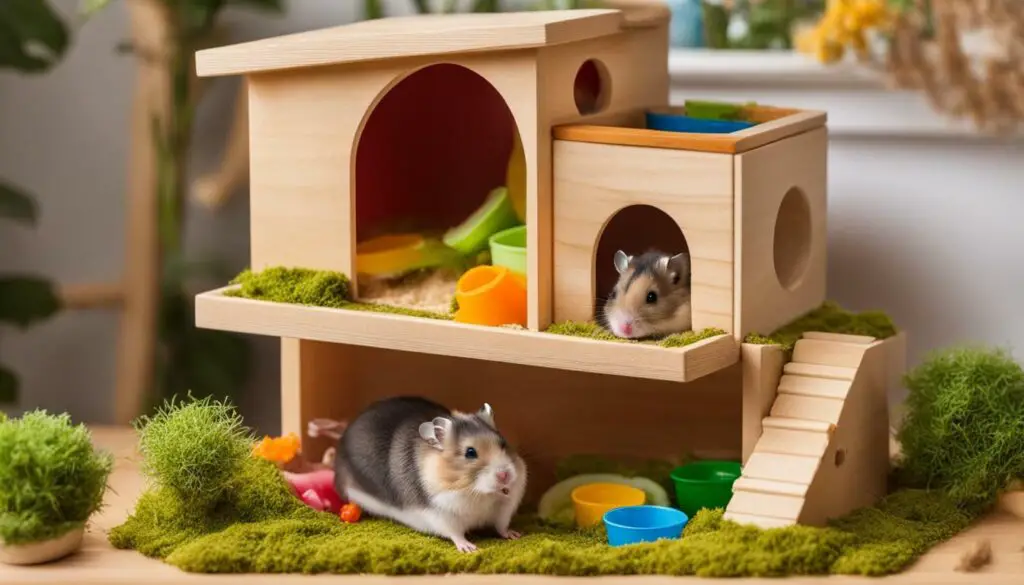
In conclusion, hamsters are solitary animals and should generally be kept alone. Understanding their natural behavior and providing them with a suitable habitat and care tailored to their solitary nature is crucial for their well-being. By following these hamster care best practices, you can ensure that your furry companion leads a happy and healthy life.
Summary of Hamster Care Guidelines
Keeping hamsters alone is generally recommended, considering their solitary nature, territorial behavior, and the risks of housing them together. Syrian and Chinese hamsters, in particular, are highly territorial and fights can occur if they are housed together. Dwarf and Roborovski hamsters can live in small colonies in the wild but it is still not recommended to keep them together domestically as fights can still break out.
Hamsters do not get lonely and do not require the company of another hamster or humans. They are content living in separate cages, where they can defend their territory and feel safe. If you do decide to keep more than one hamster, it is important to introduce them slowly and carefully to minimize the risk of aggression. Close monitoring of their interactions is crucial, and immediate separation should be implemented if any aggressive behavior occurs.
When it comes to socialization and companionship, hamsters are generally friendly with humans. They can be happily entertained through play and bonding activities without the need for another hamster’s company. Interacting with your hamster, providing them with enrichment, and ensuring their individual needs are met are essential for their well-being.
To ensure the best care for your hamster, it is important to provide a suitable habitat that caters to their specific breed and size requirements. This includes providing an appropriately sized cage, suitable bedding, hiding places, exercise wheels, and a balanced diet. Regular check-ups with a veterinarian who specializes in small animals are also recommended to address any health concerns and ensure your hamster’s overall well-being.
| Key Takeaways: |
|---|
| Hamsters should generally be kept alone due to their solitary nature and territorial behavior. |
| Syrian and Chinese hamsters are highly territorial and should not be housed together. |
| Dwarf and Roborovski hamsters can live in small colonies in the wild, but it is still not recommended to keep them together domestically. |
| Hamsters do not require the company of another hamster or humans, as they do not get lonely. |
| If keeping multiple hamsters, introduce them slowly and monitor their interactions closely to prevent aggression. |
| Interacting with your hamster and meeting their individual needs is important for their well-being. |
| Provide a suitable habitat, including an appropriately sized cage, bedding, hiding places, exercise wheels, and a balanced diet. |
| Regular veterinary check-ups are recommended for hamster health and well-being. |

By following these guidelines, you can ensure a happy and healthy life for your hamster. Remember, each hamster is unique, so it’s important to observe their behavior and adjust their care accordingly. By providing them with individual housing, monitoring their interactions, and meeting their socialization and companionship needs, you can create a fulfilling environment for your beloved hamster.
Conclusion
In conclusion, hamsters should generally be kept alone to ensure their happiness, well-being, and minimize the risk of conflicts. Hamsters are solitary animals by nature, preferring to defend their territory and live independently. Syrian and Chinese hamsters, in particular, are highly territorial species and fights can occur if they are housed together.
Although dwarf and Roborovski hamsters can live in small colonies in the wild, it is still not recommended to keep them together domestically. Even in a domestic setting, fights can break out among these small colony dwellers. Therefore, it is best to provide separate cages for each hamster, allowing them to have their own space and minimize any potential aggression.
Contrary to popular belief, hamsters do not get lonely and do not require the company of another hamster or humans. They are generally friendly with humans and can be happily entertained through play and interaction. However, if you do decide to keep more than one hamster, it is crucial to introduce them slowly and carefully to minimize the risk of aggression. Close monitoring of their interactions is essential, and immediate separation should occur if any signs of aggression are observed.
Ensuring proper care for hamsters involves providing them with suitable habitats and meeting their individual needs. By adhering to these best practices, such as providing a comfortable living environment, a balanced diet, and regular exercise, you can ensure the well-being and happiness of your hamster.
FAQ
Q: Should hamsters be kept alone?
A: Yes, hamsters should generally be kept alone as they are solitary animals and prefer to defend their territory.
Q: Are hamsters social animals?
A: No, hamsters are not social animals. They do not get lonely and do not require the company of another hamster or humans.
Q: Can hamsters live together?
A: Hamsters should be kept in separate cages and introduced slowly if you do decide to keep more than one. It is important to closely monitor their interactions and separate them if aggression occurs.
Q: What happens if hamsters are housed together?
A: Syrian and Chinese hamsters, in particular, are highly territorial and fights can occur if they are housed together. Dwarf and Roborovski hamsters can live in small colonies in the wild but it is still not recommended to keep them together domestically as fights can still break out.
Q: How should aggression between hamsters be managed?
A: If aggression occurs between hamsters, they should be immediately separated to prevent any harm. It is important to closely monitor and manage their interactions to ensure their well-being.
Q: Can hamsters live with other animals?
A: It is generally not recommended to house hamsters with other animals as conflicts and injuries can arise. Hamsters are best kept alone in their own designated habitats.
Q: Do hamsters enjoy playing with humans?
A: Yes, hamsters are generally friendly with humans and can be happily entertained through play and interaction with their caregivers.
Q: What are the best practices for hamster care?
A: Some best practices for hamster care include providing a suitable habitat, meeting their dietary and exercise needs, and ensuring a clean and safe living environment.
Q: Why should hamsters be kept alone?
A: Hamsters should be kept alone to respect their natural behavior and territoriality. Providing them with solitary living arrangements ensures their well-being and minimizes the risk of conflicts.
Q: Should hamsters be introduced slowly if kept together?
A: Yes, if you decide to keep more than one hamster, they should be introduced slowly to minimize the risk of aggression. This allows them to establish a hierarchy and adjust to each other’s presence.
Q: Do hamsters get lonely if kept alone?
A: No, hamsters do not get lonely if kept alone. They are solitary animals and prefer to live independently in their own spaces.

